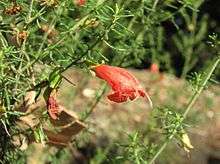Prostanthera aspalathoides
Prostanthera aspalathoides, commonly known as scarlet mint-bush, is a shrub that is native to south-eastern Australia.
| Prostanthera aspalathoides | |
|---|---|
 | |
| Prostanthera aspalathoides 'Bright Spark' | |
| Scientific classification | |
| Kingdom: | Plantae |
| Clade: | Tracheophytes |
| Clade: | Angiosperms |
| Clade: | Eudicots |
| Clade: | Asterids |
| Order: | Lamiales |
| Family: | Lamiaceae |
| Genus: | Prostanthera |
| Species: | P. aspalathoides |
| Binomial name | |
| Prostanthera aspalathoides | |
Description
Prostanthera aspalathoides has a compact upright habit, growing to 0.3–1 m (1–3 ft) high. The aromatic leaves are terete to linear-elliptic in shape and are 1.5 1.5–6 mm (0.06–0.2 in) long and 0.5–1 mm (0.02–0.04 in) wide. Flowers occur throughout the year, but are most profuse in late spring. Red, pink-red, orange or yellow flowers are solitary forming a tube in leaf axils 8–11 mm (0.3–0.4 in) long. Most Prostanthera have sensitive leaf glands, when foliage is brushed against an aromatic scent is emitted.[2][3][4]
Taxonomy and naming
The species was formally described by botanist Allan Cunningham in 1834 based on plant material collected in the vicinity of the Lachlan River in New South Wales.[1][5]
The specific epithet alludes to a similarity to plants of the genus Aspalathus.[6]
Distribution and habitat
It occurs in New South Wales and Victoria and South Australia.[1]
Uses
Use in horticulture
Prosthanthera aspalthioides is best adapted to cultivation in dry conditions with low humidity. Plants prefer a position in full sun or partial shade with good drainage and withstand moderate frost.[4][6] Cuttings are the preferred propagation method, as seed germinates slowly. Plants may also be grafted on roostocks of the hardier species Prostanthera nivea.[6]
Fragrant oil
Tests to extract cineole (also known as eucalyptol), a fragrant oil found in Prostanthera were conducted over 100 years ago by Joseph Bosisto an industrial chemist and oil distiller. Later tests on Prostanthera aspalathoides produced an oil yield of 2-3%.[3]
References
- "Prostanthera aspalathoides". Australian Plant Name Index (APNI), IBIS database. Centre for Plant Biodiversity Research, Australian Government, Canberra. Retrieved 1 June 2012.
- "Prostanthera aspalathoides". PlantNET - New South Wales Flora Online. Royal Botanic Gardens & Domain Trust, Sydney Australia. Retrieved 1 June 2011.
- Althofer, George (1978). "Cradle of Incense". ISBN 0909830134.
- Greig, D. (1987). The Australian Gardener's Wildflower Catalogue. Australia: Angus & Robertson. ISBN 0207154600.
- Bentham, George (1836). Labiatarum genera et species. pp. 453–454. Retrieved 22 December 2018.
- "Prostanthera aspalathoides". Australian Native Plants Society (Australia). Retrieved 12 May 2020.